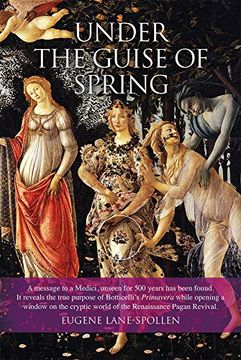Under the Guise of Spring: A Mesage to a Medici, Unseen for 500 Years has Been Found. It Reveals the True Purpose of Botticelli'S Primavera, While. World of the Renaissance Pagan Revival
Synopsis "Under the Guise of Spring: A Mesage to a Medici, Unseen for 500 Years has Been Found. It Reveals the True Purpose of Botticelli'S Primavera, While. World of the Renaissance Pagan Revival"
A chance discovery provided the author with the key to unlocking the centuries old enigma of Botticelli's Primavera, a masterpiece painted for the private viewing of a Medici. Its pagan figures in a paradisical spring meadow illuminated the cryptic world of the Renaissance pagan revival. Botticelli's allegory emerged to address its personal message to a young Medici. Botticelli's cleverly disguised message for Lorenzo Minore, is to be found on the right side of La Primavera, where Chloris draws Zephyr's attention to it. This book is extremely well researched and beautifully produced with eighty color plates. Lane-Spollen clearly explains the fusion of Christian and pagan imagery which is reflected in La Primavera, placing it in the wider context of Italy's religion and politics. The author employs a readable style which will make this book suitable for those familiar with this period looking for more detail about a beloved painting, and those who are new to the Renaissance and Art History. Lane-Spollen gives a clear overview of why and how Botticelli conveyed his message in disguise. An esteemed circle of scholars around the Medici, disillusioned with a worldly and corrupted medieval Church, searched for a purer, unadulterated Christianity in the pre-Christian foundations of their faith. This was a sensitive occupation in a society where the reach of the Church was present in all matters public and private. In 1460 a manuscript was brought to Cosimo de'Medici. Its author, Hermes, was revered by Augustine and the early Church Fathers. Its revelations on the true nature of Man held the evidence they were seeking and stood in stark contrast to the medieval Church view in which the lowly humble sinner must throw himself on the mercy of the Church for his redemption. The Hermetic corpus which so inspired the Medici circle, saw Man as unique among all species, of unlimited potential and possessing a 'spark of the Divine'. As Burckhardt noted, "it became the breath of life for all the most instructed minds of Europe". For medieval man, it heralded his rebirth, his Renaissance. Expressing this newly discovered 'God-like' being in art stimulated the creative imagination of Renaissance artists like Botticelli, Leonardo, and Raffaello. Lane-Spollen gives a clear overview of why and how Botticelli conveyed his message in code: An esteemed circle of scholars around the Medici, disillusioned with a worldly and corrupted medieval Church, searched for a purer, unadulterated Christianity in the pre-Christian foundations of their faith. This was a dangerous occupation in a society where the reach of the Church was present in all matters public and private. In 1460 a manuscript was brought to Cosimo de'Medici. Its author, Hermes, was revered by Augustine and the early Church Fathers. Its revelations on the true nature of Man held the evidence they were seeking and stood in stark contrast to the teachings of the medieval church and had no place for man as a lowly humble sinner who must throw himself on the mercy of the Church. Neoplatonism and the Hermetic corpus which so inspired the Medici circle, saw Man as unique among all species and possessing a 'spark of the divine'.Though heretical and blasphemous in the extreme, this philosophy had a profound effect and spread rapidly. As Burckhardt noted, 'it became the breath of life for all the most instructed minds of Europe'. Convinced by its impeccable provenance, the Medici circle of philosophers and poets strived to merge the three great but competing religions, Judaism, Islam and Christianity, into a single religion in harmony with their original pre-Christian foundations. Expressing this newly discovered 'God-like' being in art stimulated the creative imagination of the early Renaissance as artists like Botticelli, Leonardo, Michaelangelo and Raphaello strove to express 'divine' Man's dignity, his innate capability and the profound depths of his potential for greatness.

